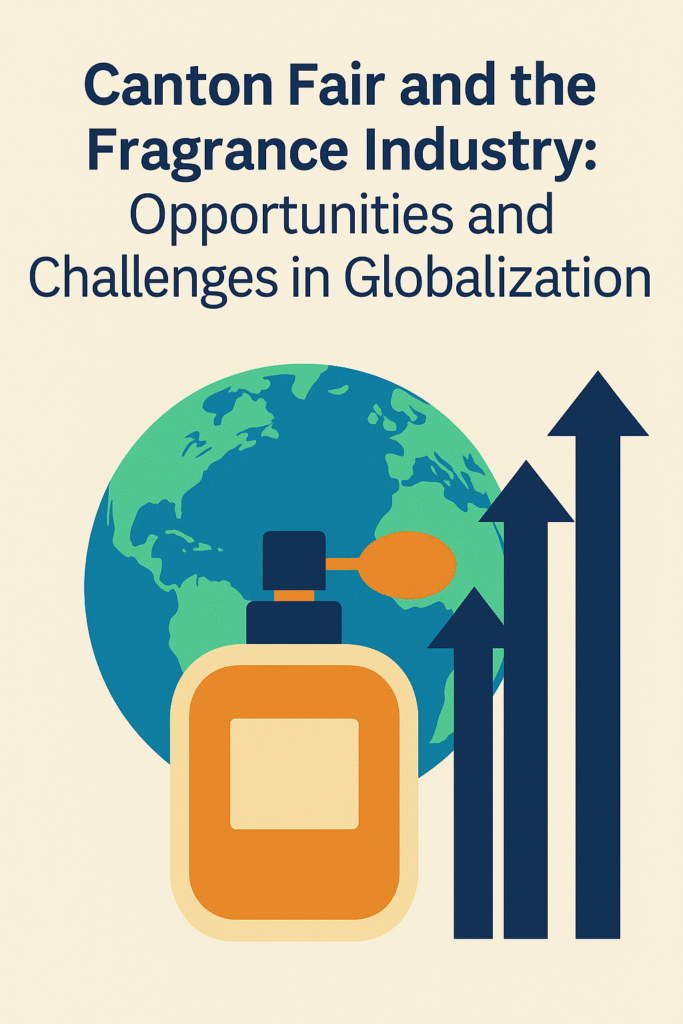Canton Fair and the Fragrance Industry: Opportunities and Challenges in Globalization
The Canton Fair (China Import and Export Fair) is a key event in global trade, providing an excellent platform for fragrance companies to showcase their products and expand their markets. This article explores the role of fragrance manufacturers in the Canton Fair, analyzes global fragrance market trends, and presents strategies for fragrance companies to leverage the fair for international growth.
Overview of the Canton Fair
The Canton Fair, held twice a year in Guangzhou, is one of the largest and most influential trade exhibitions in the world. Covering a wide range of industries including electronics, machinery, building materials, consumer goods, food, and medical products, the Canton Fair attracts exhibitors and buyers from over 200 countries and regions. The event facilitates transactions that amount to billions of dollars annually. For the fragrance industry, this fair is a key platform for product showcasing, networking, and establishing new business relationships.
Global Fragrance Market Trends
The global fragrance market has experienced consistent growth and is expected to continue expanding in the coming years. According to Grand View Research, the market size was valued at USD 54.52 billion in 2023 and is forecast to reach USD 74.76 billion by 2030, with a compound annual growth rate (CAGR) of 4.7% from 2024 to 2030.
Key Drivers of Growth:
- Increasing Demand for Personal Care and Household Products: The rising demand for fragranced products in personal care and cleaning products is driving the fragrance market.
- Natural and Organic Products: The shift towards organic and sustainable products is fueling the demand for natural fragrances.
- Growth in Emerging Markets: Asia-Pacific, particularly China and India, is seeing rapid growth, contributing to the increasing market size.
With digital sales channels expanding, fragrance companies can also leverage e-commerce platforms to boost global sales.
How Fragrance Companies Can Benefit from the Canton Fair
1. Showcase Products and Enhance Brand Awareness
The Canton Fair provides fragrance companies with the opportunity to showcase their products to a global audience. By participating in the fair, companies can demonstrate their products’ features and benefits through live demos and sample displays, increasing brand recognition in the international market.
2. Expand Markets and Build Customer Relationships
One of the key advantages of the Canton Fair is the ability to connect with buyers from all over the world. Fragrance manufacturers can meet potential customers from various regions, including emerging markets such as Southeast Asia, Africa, and South America, providing an avenue for global market expansion.
3. Network and Collaborate on Innovation
The fair is not only a sales platform but also an opportunity for technical exchange. Fragrance companies can network with other industry leaders to learn about market trends, exchange ideas, and explore potential collaborations on new product development.
Leveraging the Canton Fair for Global Expansion: Key Strategies
1. Targeted Exhibition Strategy
Fragrance companies should carefully select exhibition zones and booth placements based on their target markets. For example, fragrance products for the food industry should be exhibited in the food section, while personal care and cleaning products should be placed in the daily goods section. Tailoring the exhibition to specific industries helps attract the right audience.
2. Enhance Brand Image
Building a strong, professional brand presence is crucial at the Canton Fair. Fragrance companies should focus on booth design, effective promotional materials, and well-trained staff to convey a professional image. In addition, leveraging social media and digital tools during the fair can help maximize visibility and extend the reach of the company’s branding efforts.
3. Develop Strong Customer Relationships
The fair provides an opportunity to engage directly with potential customers. It’s important for fragrance companies to understand their clients’ needs and provide tailored solutions. Following up with customers post-event is equally important for fostering long-term relationships and securing repeat business.
4. Diversify Cooperation Models
In addition to product sales, fragrance companies can explore joint ventures, co-branded projects, and collaborations on research and development. These partnerships can enhance innovation and provide companies with new avenues for growth in the global market.
The Future of the Fragrance Industry and the Canton Fair
The fragrance industry is poised for continued growth, driven by trends in sustainability, consumer demand for natural ingredients, and the expansion of emerging markets. The Canton Fair will remain a vital platform for fragrance companies to connect with global buyers, explore new business opportunities, and stay ahead of industry trends.
Key Trends Shaping the Future of the Fragrance Industry:
- Sustainability: Growing demand for eco-friendly and sustainable products is influencing fragrance formulations, making it essential for companies to innovate and meet consumer expectations.
- Digitalization: The rise of e-commerce and digital platforms provides fragrance companies with new ways to reach customers and market their products internationally.
- Customization: Consumers are increasingly seeking personalized fragrance experiences, which offers fragrance companies the opportunity to diversify their product lines and meet individual preferences.
Conclusion: Why Fragrance Companies Should Participate in the Canton Fair
The Canton Fair offers fragrance companies a unique opportunity to expand their global reach, showcase innovative products, and build valuable customer relationships. By adopting a well-planned exhibition strategy and leveraging the fair’s networking potential, fragrance companies can position themselves for long-term success in the growing global market.
With the fragrance market continuing to expand, especially in emerging regions, the Canton Fair is an invaluable platform for fragrance companies to explore new business opportunities and strengthen their presence in the international marketplace.
